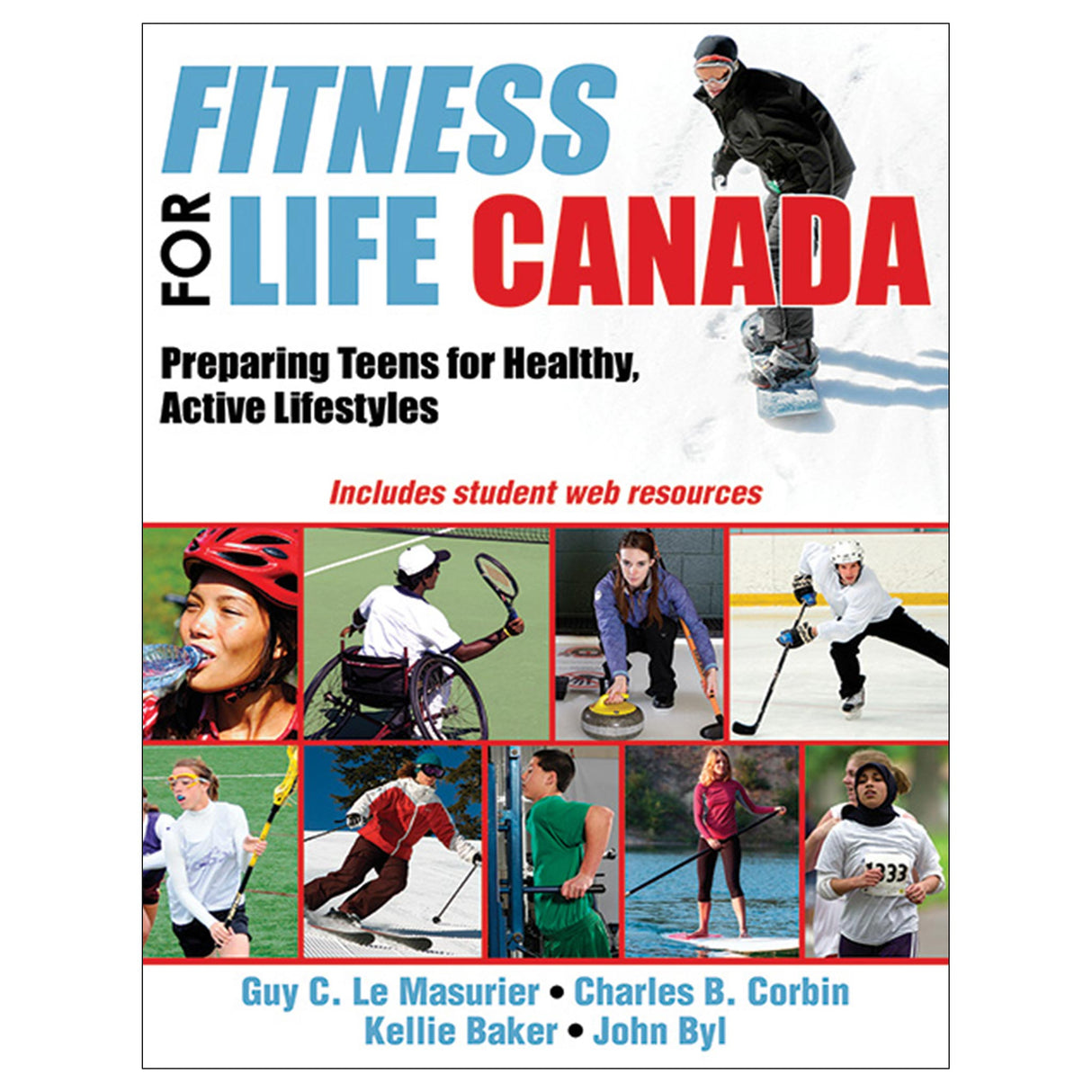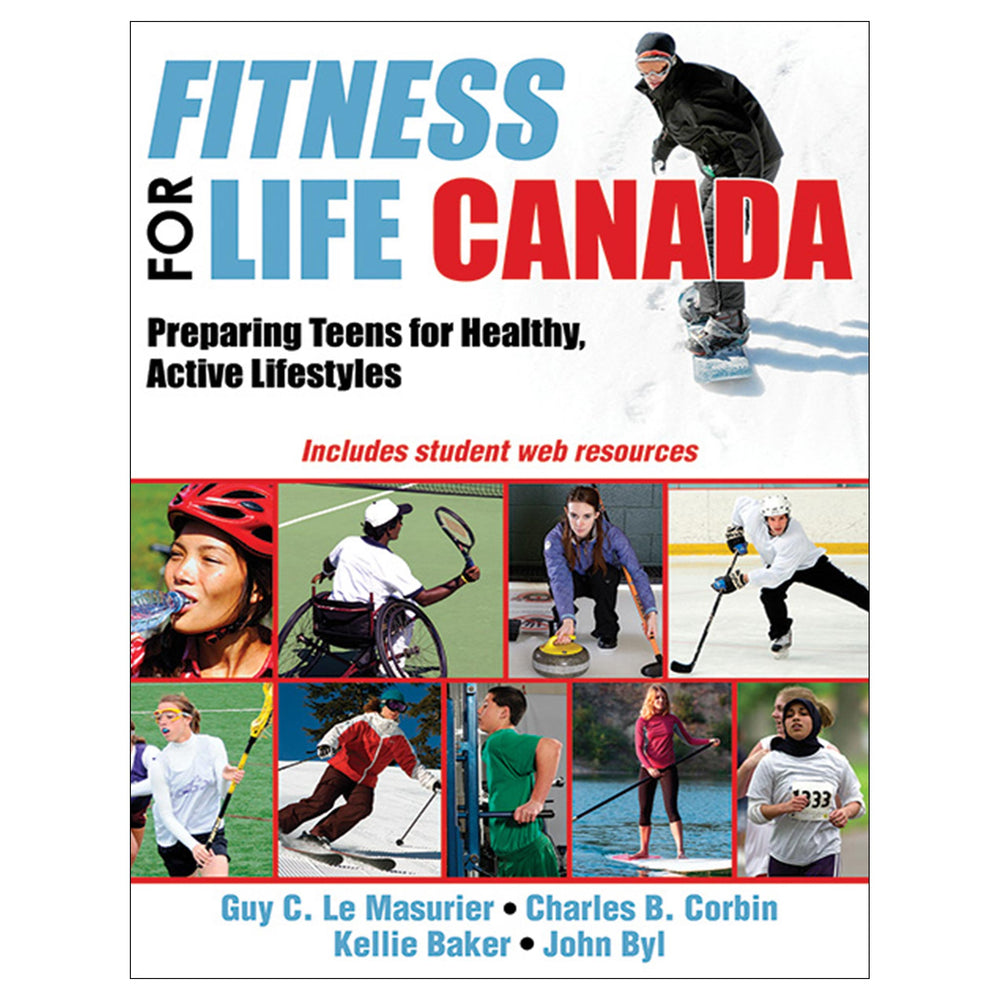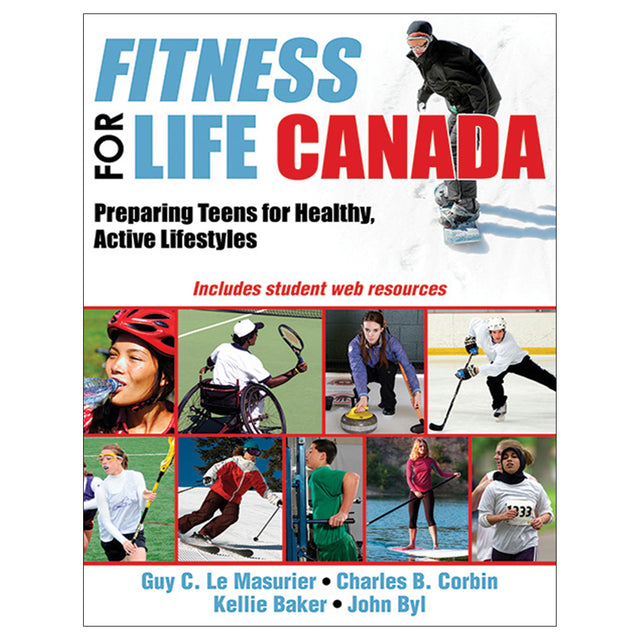Fitness for Life Canada With Web Resources
Preparing Teens for Healthy, Active Lifestyles
$48.00 USD
Fitness for Life Canada: Preparing Teens for Active and Healthy Living is the only health and fitness education program backed by research and focused on shifting teens from dependence to independence when it comes to lifelong healthy lifestyles. Through Fitness for Life Canada, students are engaged in the process of personal program planning for a variety of health behaviours including physical activity, fitness, and health eating. This evidence-based and standards-based program follows a pedagogically sound scope and sequence to enhance student learning and progress and presents the science of healthy living at age-appropriate levels.
Research clearly demonstrates that active and healthy adults use a variety of self-management skills to maintain their positive behaviours. Fitness for Life Canada helps students develop numerous self-management skills—such as self-assessment, self-monitoring, goal setting, finding social support, overcoming barriers, and managing time—to prepare them to independently engage in healthy lifestyles. Students also learn to engage in community physical activity opportunities, with national sport and health organizations, and with technology that supports healthy lifestyles.
Through Fitness for Life Canada, students explore these aspects:
• The foundations of active and healthy living, including adopting healthy lifestyles and self-management skills and setting goals and planning personal programs
• Learning the basics for lifelong activity and health, including engaging in smart and safe physical activity, knowing how much activity is enough, and understanding healthy eating
• Beginning activity and building fitness, including participating in moderate- and vigorous-intensity physical activity and developing cardiorespiratory endurance
• Building muscle fitness and flexibility, including understanding muscle fitness applications and ergogenic aids
• Maintaining a healthy lifestyle, including achieving a healthy body composition, choosing nutritious foods, and making good consumer choices
• Creating positive and healthy experiences, including managing stress, developing lifelong leadership skills, understanding reproductive and sexual wellness, and making wise choices regarding alcohol, drugs, and tobacco
Fitness for Life Canada has extensive teacher resources with more than 100 lesson plans (classroom and activity based) that provide teachers with numerous options for student assessment and opportunities to demonstrate evidence of student learning (e.g., quizzes, tests, worksheets, student demonstrations, student projects). Teachers can integrate the program with existing curricula or deliver it as a stand-alone program. They can also apply our Fitness Club approach to deliver fitness education to large numbers of students using multiple activity areas.
Special Features in Chapters and Units
Every chapter in the student text features two classroom lessons, one feature that engages students with prominent Canadian sport organizations and health organizations, and a chapter review. The book devotes multiple lessons to personal program planning, implementation, and evaluation. Go to Sample Content to view sample page layouts that show thhese special features.
Each unit offers a Consumer Corner feature. The teacher web resources feature the same chapter content as the student text plus three physical activity lessons per chapter that help students apply what they’ve learned from the classroom lessons.
In addition, the chapters have a series of other prominent features:
• Lesson objectives direct student learning.
• Lesson vocabulary helps students understand multiple uses of words (definitions in glossary and online).
• Art includes a version of the physical activity pyramid for teens.
• Photos and design give the chapters a refreshing student-friendly look with its dynamic four-color design.
• Muscle art identifies the muscles used in each exercise.
• Fit Facts give quick information about relevant topics.
• Quotes from famous people reveal their thoughts on fitness, health, and wellness.
• Fitness Technology offers opportunities for students to use and study technology.
• Science in Action provides in-depth coverage of innovations in fitness, health, and wellness.
• Self-Assessment allows students to evaluate their fitness, health, and wellness as the first step in personal planning for improvement.
• Taking Charge and Self-Management allow students to learn self-management skills for adopting healthy behaviors and interacting with other students to solve problems encountered by hypothetical teens.
• Taking Action features activities that are supported by the lesson plans.
• Consumer Corner helps students become good consumers of information on fitness, health, and wellness as they learn how to separate fact from fiction.
Web-Based Resources
Fitness for Life Canada provides physical educators with numerous delivery and assessment options in health and physical education. Specifically, the program has more than 100 detailed activity- and classroom-based lesson plans that can be delivered out of the box for beginner teachers and are modifiable for experienced teachers. The lesson plans are supported with worksheets, activity cards, PowerPoint slides, quizzes, chapter and unit tests, an online test bank, supplemental project ideas, and an online student web resource.
Fitness for Life Canada creates new assessment approaches for teachers that allow students to demonstrate evidence of learning. These include quizzes, tests, portfolios (including digital), demonstrations (live, video, and pictures), journals and reflections (written and video), class presentations, and video presentations.
For students, web resources include the following:
• Video clips that demonstrate the self-assessments in each chapter
• Video clips that demonstrate the exercise in selected chapters
• Worksheets without answers
• Review questions from the text presented in an interactive format so students can check their level of understanding
• Expanded discussions of topics marked by web icons in the text
• Vocabulary terms with definitions
Teacher web resources include the following:
• An introduction that describes the body of knowledge and pedagogical foundations behind Fitness for Life Canada as well as the evidence supporting its effectiveness
• Daily lesson plans, including five lessons per chapter: two classroom plans and three activity plans
• Worksheets with answers
• Premade chapter and unit quizzes with answers
• Activity cards and task cards
• Presentation package of slides with the key points for each lesson
• A test bank that teachers can use to make their own quizzes if they prefer
Fitness for Life Canada develops higher-order physical literacy knowledge and skills that help students become active and healthy adults. Fitness for Life Canada focuses on developing students’ knowledge of health and health-related fitness concepts, training principles, and personal physical activity and fitness program planning. That knowledge is combined with numerous self-management skills that are critical for maintaining physical activity, healthy eating, and general health behaviours. In short, Fitness for Life Canada enhances engagement, learning, and assessment while paving the way to a healthy lifestyle throughout the life span.
Audience
Physical education and health textbook for students in grades 8 to 11 in Canada. Reference for secondary PE teachers or for undergrad courses in PE teacher preparation.
Touring Fitness for Life Canada
Unit I Foundations of Active and Healthy Living
Chapter 1. Fitness, Health, and Physical Literacy
Lesson 1.1: Lifelong Fitness, Health, and Wellness
Self-Assessment: Physical Fitness Challenges
Lesson 1.2: Developing Physical and Health Literacy
Taking Charge: Learning to Self-Assess
Self-Management: Skills for Learning to Self-Assess
Taking Action: Fundamental Movement Skills
Get Active With PHE Canada
Chapter Review
Chapter 2. Adopting Healthy Lifestyles and Self-Management Skills
Lesson 2.1: Adopting Healthy Lifestyles
Self-Assessment: Practicing Physical Fitness Tests
Lesson 2.2: Stages of Change and Learning Self-Management Skills
Taking Charge: Building Knowledge and Understanding
Self-Management: Skills for Building Knowledge and Understanding
Taking Action: Being Active in the Outdoors
Get Active With Explore Magazine
Chapter Review
Chapter 3. Setting Goals and Planning Personal Programs
Lesson 3.1: Goal Setting
Self-Assessment: Assessing Muscle Fitness
Lesson 3.2: Personal Program Planning
Taking Charge: Setting Goals
Self-Management: Skills for Setting Goals
Taking Action: Walking for Health
Getting Active With ParticipAction
Chapter Review
Unit II Preparing for Lifelong Activity and Health
Chapter 4. Engaging in Safe and Smart Physical Activity
Lesson 4.1: Safe and Smart Physical Activity
Self-Assessment: Body Composition and Flexibility
Lesson 4.2: Health and Wellness Benefits
Taking Charge: Reducing Risk Factors
Self-Management: Skills for Reducing Risk Factors
Taking Action: The Warm Up
Get Active With CSEP
Chapter Review
Chapter 5. Supporting Physical Activity and Healthy Eating
Lesson 5.1: Factors Influencing Physical Activity and Healthy Eating
Self-Assessment: Assessing Social Support
Lesson 5.2: Social Support for Physical Activity and Healthy Eating
Taking Charge: Finding Social Support
Self-Management: Skills for Finding Social Support
Taking Action: Accessing Social Support
Get Active With Right To Play
Chapter Review
Chapter 6. How Much Physical Activity and Fitness Is Enough?
Lesson 6.1: How Much Physical Activity Is Enough?
Self-Assessment: PACER and Trunk Lift
Lesson 6.2: How Much Fitness Is Enough?
Taking Charge: Learning to Self-Monitor
Self-Management: Skills for Learning to Self-Monitor
Taking Action: Physical Activity Pyramid Circuit
Get Active With Sport for Life Society
Chapter Review
Unit III Being Active and Building Fitness
Chapter 7. Participating in Moderate-Intensity Physical Activity
Lesson 7.1: Moderate-Intensity Physical Activity Facts
Self-Assessment: Walking Test
Lesson 7.2: Preparing a Moderate-Intensity Physical Activity Plan
Taking Charge: Learning to Manage Time
Self-Management: Skills for Managing Time
Taking Action: Your Moderate-Intensity Physical Activity Plan
Get Active With HALO
Chapter Review
Chapter 8. Developing Cardiorespiratory Endurance
Lesson 8.1: Cardiorespiratory Endurance Facts
Self-Assessment: Step Test and One-Mile Run Test
Lesson 8.2: Building Cardiorespiratory Endurance
Taking Charge: Self-Confidence
Self-Management: Skills for Building Self-Confidence
Taking Action: Target Heart Rate Workout
Get Active With Canada Soccer
Chapter Review
Chapter 9. Engaging in Vigorous-Intensity Physical Activity
Lesson 9.1: Vigorous Aerobics, Sport, and Recreation
Self-Assessment: Assessing Jogging Techniques
Lesson 9.2: Preparing and Performing a Safe and Vigorous-Intensity Physical Activity Program
Taking Charge: Choosing Good Activities
Self-Management: Skills for Choosing Good Activities
Taking Action: Your Vigorous-Intensity Physical Activity Plan
Get Active With Canada Basketball
Chapter Review
Unit IV Building Muscle Fitness and Flexibility
Chapter 10. Building Muscle Fitness: The Basics
Lesson 10.1: Muscle Fitness Facts
Self-Assessment: Muscle Fitness Testing
Lesson 10.2: Building Muscle Fitness
Taking Charge: Overcoming Barriers
Self-Management: Skills for Overcoming Barriers
Taking Action: Resistance Machine Exercises
Get Active With canfitpro
Chapter Review
Chapter 11. Muscle Fitness Applications
Lesson 11.1: Core Fitness, Posture, and Back Care
Self-Assessment: Healthy Back Test and Assessing Posture
Lesson 11.2: Ergogenic Aids and Preparing a Muscle Fitness Plan
Taking Charge: Preventing Relapse
Self-Management: Skills for Preventing Relapse
Taking Action: Your Muscle Fitness Exercise Plan
Get Active With Hockey Canada
Chapter Review
Chapter 12. Developing Flexibility
Lesson 12.1: Flexibility Facts
Self-Assessment: Arm, Leg, and Trunk Flexibility
Lesson 12.2: Preparing a Flexibility Exercise Program
Taking Charge: Building Positive Attitudes
Self-Management: Skills for Building Positive Attitudes
Taking Action: Your Flexibility Exercise Plan
Get Active With Canada Snowboard
Chapter Review
Unit V Making Healthy Food and Fitness Choices
Chapter 13 Maintaining a Healthy Body Composition
Lesson 13.1: Body Composition Facts
Self-Assessment: Body Measurements
Lesson 13.2: Energy Balance
Taking Charge: Improving Physical Self-Perception
Self-Management: Skills for Self-Perception
Taking Action: Elastic Band Workout
Get Active With Swimming Canada
Chapter Review
Chapter 14. Choosing Nutritious Food
Lesson 14.1: A Healthy Diet
Self-Assessment: Energy Balance
Lesson 14.2: Making Healthy Food Choices
Taking Charge: Saying No
Self-Management: Skills for Saying No
Taking Action: Burn It Up Workout
Get Active With Dietitians of Canada
Chapter Review
Chapter 15. Making Good Consumer Choices
Lesson 15.1: Health and Fitness Misconceptions
Self-Assessment: Your Personal Fitness Battery
Lesson 15.2: Evaluating Health Clubs, Equipment, Media, and Internet Materials
Taking Charge: Learning to Thinking Critically
Self-Management: Skills for Thinking Critically
Taking Action: My Health and Fitness Club
Get Active With the YMCA
Chapter Review
Unit VI. Creating Positive and Healthy Experiences
Chapter 16 Choosing Healthy Lifestyles
Lesson 16.1: Lifestyle Choices for Health, Fitness, and Wellness
Self-Assessment: Healthy Lifestyle Questionnaire
Lesson 16.2: Planning for a Healthy Lifestyle
Taking Charge: Positive Self-Talk
Self-Management: Skills for Positive Self-Talk
Taking Action: Your Healthy Lifestyle Plan
Get Active With Canadian Parks and Recreation Association
Chapter Review
Chapter 17. Managing Stress
Lesson 17.1: Facts About Stress
Self-Assessment: Identifying Signs of Stress
Lesson 17.2: Stress Management
Taking Charge: Managing Competitive Stress
Self-Management: Skills for Managing Competitive Stress
Taking Action: Relaxation Exercises for Managing Stress
Get Active With Canadian Yoga Alliance
Chapter Review
Chapter 18. Lifelong Leadership and Physical Activity
Lesson 18.1: Leadership Skills in Physical Activity
Self-Assessment: Developing Leadership Skills
Lesson 18.2: Active Living Opportunities
Taking Charge: Conflict Resolution
Self-Management: Skills for Conflict Resolution
Taking Action: Team Building
Get Active With Canadian Coaching Association
Chapter Review
Unit VII Making Lifestyle Choices
Chapter 19. Alcohol, Drugs, and Tobacco
Lesson 19.1: Alcohol Use and Abuse
Self-Assessment: My Alcohol Knowledge
Lesson 19.2: Drugs and Tobacco
Taking Charge: Building Strong Refusal Skills
Self-Management: Skills for Strong Refusal
Taking Action: Raising Your Awareness About Alcohol, Drug, and Tobacco Abuse
Get Active With MADD Canada
Chapter Review
Chapter 20. Reproductive and Sexual Wellness
Lesson 20.1: Sexuality and Sexual Orientation
Self-Assessment: Sexuality Survey
Lesson 20.2: Birth Control, Pregnancy, and Sexually Transmitted Infections
Taking Charge: Improving Social Self-Perception
Self-Management: Skills for Improving Self-Perception
Taking Action: Sexual Well-Being
Get Active With SexandU
Chapter Review
Chapter 21. Healthy Relationships
Lesson 21.1: Family Life and Family Structure
Self-Assessment: Rate Your Relationships
Lesson 21.2: Building and Supporting Healthy Relationships
Taking Charge: Dating Coercion and Violence
Self-Management: Skills for Reducing Your Risk of Experiencing Dating Coercion and Violence
Taking Action: Taking Dating Violence Seriously
Get Active With WAVAW Rape Crisis Centre
Chapter Review
How Much Moderate-Intensity Physical Activity Is Enough?
The FIT Formula and Nutrition
Student Web Resources
Fitness for Life offers student supporting resources.
https://canada.humankinetics.com/pages/fitness-for-life-k-12-resources
The student web resource accessible with each student text includes the following:
- Video clips that demonstrate the self-assessments in each chapter
- Video clips that demonstrate the exercise in selected chapters
- Worksheets without answers
- Review questions from the text presented in an interactive format so students can check their level of understanding
- Expanded discussions of topics marked by web icons in the text
- Vocabulary terms with definitions
The online teacher ancillary resources below are available free to each school adoption and purchase of a class set. They include the following:
- An introduction that describes the body of knowledge and pedagogical foundations behind Fitness for Life Canada as well as the evidence supporting its effectiveness
- Daily lesson plans, including five lessons per chapter: two classroom plans and three activity plans
- Worksheets with answers
- Premade chapter and unit quizzes with answers
- Activity cards and task cards
- Presentation package of slides with the key points for each lesson (see more below)
- A test bank that teachers can use to make their own quizzes if they prefer (see more below)
The Fitness for Life Canada presentation package includes over 450 slides of key concepts, figures, and tables for each lesson in the book.
Test Package
The Fitness for Life Canada test package includes a bank of over 750 true-or-false, fill-in-the-blank, essay and short-answer, matching, and multiple-choice questions. Instructors can use premade tests for each chapter or each unit or create their own tests from the question bank using Respondus.
All teacher ancillary materials for this text are free to course adopters with the purchase of a class set, and available online at www.HumanKinetics.com/FitnessForLifeCanada.





